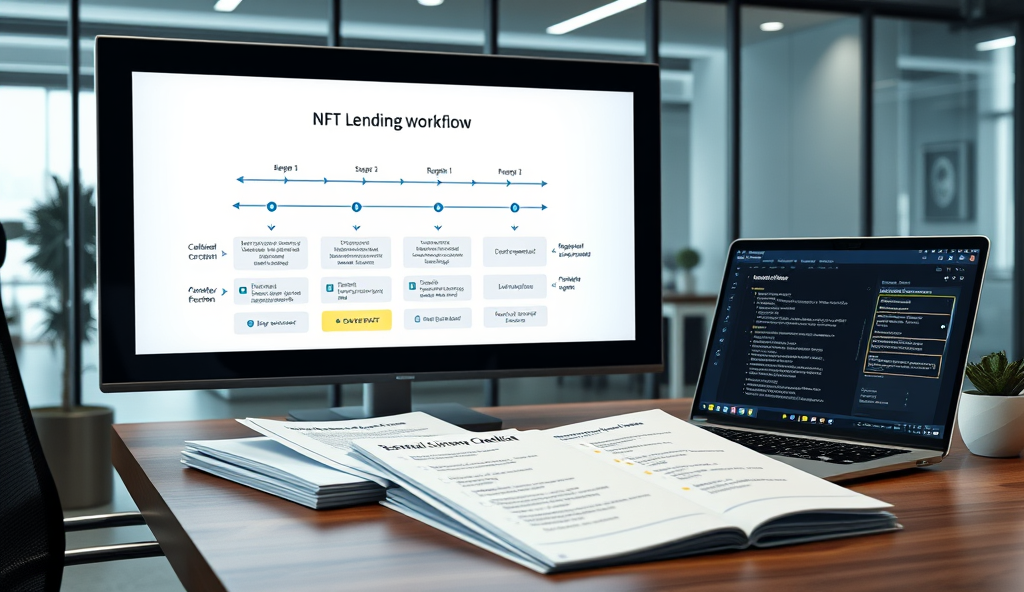Introduction to Music NFTs and Their Growing Popularity
Music NFTs have surged in popularity, with sales reaching $25 million in 2022 alone as artists like Grimes and 3LAU pioneered the space. This digital revolution offers creators new revenue streams by tokenizing exclusive content, from unreleased tracks to concert experiences, directly connecting with fans.
However, alongside these opportunities lie significant risks, including security issues with music NFTs and market volatility that can impact artists’ earnings. The lack of regulation in this emerging space has also led to scams in the music NFT market, leaving some creators vulnerable to financial losses.
As we explore the potential dangers of music NFTs, it’s crucial to first understand their foundational mechanics before assessing their risks. The next section will break down how music NFTs function, setting the stage for a deeper analysis of their challenges.
Key Statistics

Understanding the Basics of Music NFTs
Music NFTs have surged in popularity with sales reaching $25 million in 2022 alone as artists like Grimes and 3LAU pioneered the space.
Music NFTs are blockchain-based tokens representing ownership or access rights to digital music assets, enabling artists to monetize exclusive content directly. Unlike traditional streaming, these tokens can include unique perks like unreleased tracks, VIP experiences, or royalties, as seen with 3LAU’s $11.6 million NFT album sale in 2021.
Built on smart contracts, music NFTs automate royalty payments and verify authenticity, reducing intermediaries but introducing technical complexities. For example, platforms like Sound.xyz use Ethereum to tokenize songs, though gas fees and scalability issues remain hurdles for smaller artists.
While these mechanics empower creators, they also expose them to security issues with music NFTs, such as smart contract vulnerabilities or copyright disputes. Understanding these foundational elements is key before evaluating the potential benefits and risks of releasing music as NFTs.
The Potential Benefits of Releasing Music as NFTs
The 2022 NFT market crash saw average prices drop 74% according to NonFungible.com leaving many creators with unsold inventory and devalued assets.
Despite the security issues with music NFTs discussed earlier, artists gain direct monetization through tokenized sales, bypassing traditional revenue splits with labels or distributors. For instance, independent artist Daniel Allan earned over $100,000 in 24 hours by selling NFT albums on Mirror.xyz, demonstrating how decentralized platforms empower creators financially.
Smart contracts also enable automated royalty distributions, ensuring artists receive instant payments without intermediaries delaying transactions. Platforms like Royal.io allow fans to invest in song rights, creating recurring income streams as seen with Nas’s 2022 NFT release generating ongoing royalties.
These mechanics foster deeper fan engagement by offering exclusive perks like backstage passes or voting rights on creative decisions. However, these advantages must be weighed against the financial risks associated with music NFTs, including market volatility and fraudulent activities, which we’ll explore next.
Financial Risks Associated with Music NFTs
The extreme price swings in music NFTs create financial risks for artists with some collections losing 90% of their value within months.
While music NFTs offer direct monetization and fan engagement opportunities, artists face significant financial risks including price crashes and fraudulent schemes. The 2022 NFT market crash saw average prices drop 74% according to NonFungible.com, leaving many creators with unsold inventory and devalued assets.
Scams like fake NFT drops or phishing attacks have cost artists millions, as seen when producer RAC lost $300,000 in a counterfeit token scheme. These security issues with music NFTs highlight the need for thorough platform vetting before releasing digital collectibles.
The lack of regulation in music NFTs also exposes artists to copyright disputes and royalty payment uncertainties, which we’ll examine alongside market volatility next. Such financial risks require careful risk assessment before entering the space.
Market Volatility and Its Impact on NFT Value
The energy-intensive nature of blockchain transactions exacerbates the ecological footprint of music NFTs with Ethereum's pre-Merge proof-of-work system consuming as much electricity annually as entire countries like Finland.
The extreme price swings in music NFTs create financial risks for artists, with some collections losing 90% of their value within months, as observed in the 2022-2023 market correction. Unlike traditional royalties, NFT earnings depend entirely on speculative demand, leaving creators vulnerable to sudden downturns like the Bored Ape Yacht Club’s 85% floor price drop.
Platforms like OpenSea show music NFTs often trade below mint prices, with 60% of Sound.xyz drops reselling at losses within six months according to CryptoSlam data. This volatility stems from crypto market correlations, where Bitcoin’s 30% swings directly impact NFT liquidity and collector behavior.
These unpredictable value fluctuations compound the financial risks in music NFTs, making consistent revenue difficult—a challenge worsened by high gas fees we’ll explore next. Artists must weigh this instability against potential rewards when entering the space.
High Gas Fees and Transaction Costs for Artists
Many artists enter the NFT space expecting quick profits but 73% of music NFTs sold for under $100 in 2023 according to CryptoArt.io data with most failing to resell.
The financial instability of music NFTs worsens when accounting for Ethereum gas fees, which surged to $200+ per transaction during peak demand in 2021 according to Etherscan data. These unpredictable costs can erase 10-30% of an artist’s revenue from small NFT drops, as seen in Sound.xyz’s February 2023 report showing 40% of creators netting less than mint prices after fees.
Layer-2 solutions like Polygon reduce but don’t eliminate fees, with OpenSea data showing average $5-15 costs still consuming 15% of sub-$100 music NFT sales. This creates disproportionate burdens for emerging artists, exemplified by UK producer RAC’s disclosure that gas fees consumed 22% of his $50 NFT collection’s proceeds.
These hidden costs compound the market volatility risks discussed earlier, while also introducing legal complexities—as fluctuating transaction values create accounting challenges we’ll examine next regarding copyright enforcement. Artists must budget for fee spikes that can make small-scale NFT projects economically unviable.
Legal and Copyright Concerns with Music NFTs
Beyond financial volatility and gas fees, music NFTs introduce complex copyright challenges, as ownership transfers don’t automatically include publishing rights—a 2022 Ditto Music study found 68% of artists mistakenly believed NFT buyers gained full usage rights. This confusion led to high-profile disputes like DJ 3LAU’s $11 million NFT sale, where secondary traders unknowingly violated original licensing terms.
Smart contracts often lack standardized copyright frameworks, creating legal gray areas when reselling music NFTs, evidenced by UK producer Illmind’s 2023 case where unauthorized samples in resold NFTs triggered $150k in copyright claims. These risks compound when considering international copyright variations, as blockchain transactions cross jurisdictions instantly while laws lag behind.
Such legal uncertainties directly impact NFT security too, as poorly drafted contracts become targets for exploitation—a natural segue into examining smart contract vulnerabilities next. Artists must consult legal specialists before minting to avoid costly litigation from ambiguous ownership terms.
Smart Contract Vulnerabilities and Security Risks
Flaws in smart contract code expose artists to financial risks in music NFTs, with blockchain analytics firm Chainalysis reporting $2.8 billion lost to crypto scams in 2022—many targeting NFT projects. The infamous Frosties NFT rug pull in 2022 saw developers drain $1.3 million by embedding withdrawal functions in their smart contract, a tactic that could easily replicate in music NFT launches.
Even audited contracts carry risks, as shown when Bored Ape Yacht Club’s smart contract exploit allowed hackers to steal NFTs worth $360k—similar vulnerabilities could compromise exclusive music drops. Security issues with music NFTs intensify when artists use template contracts without customizing royalty structures, leaving loopholes for malicious actors to bypass payment splits during secondary sales.
These technical vulnerabilities compound the legal challenges with music NFTs discussed earlier, while also contributing to environmental concerns related to NFT transactions through wasted computational resources during attacks. Artists must prioritize smart contract audits from firms like CertiK before minting, as 23% of Web3 hacks in 2023 stemmed from unaudited code according to Immunefi’s cybersecurity report.
Environmental Concerns Related to NFT Transactions
The energy-intensive nature of blockchain transactions exacerbates the ecological footprint of music NFTs, with Ethereum’s pre-Merge proof-of-work system consuming as much electricity annually as entire countries like Finland. Artists face backlash from environmentally conscious fans, as a single NFT minting transaction can generate over 200kg of CO2—equivalent to a 500-mile car ride according to Digiconomist’s 2022 estimates.
Transitioning to proof-of-stake blockchains like Solana or post-Merge Ethereum reduces energy use by 99%, yet secondary sales still trigger carbon emissions through smart contract executions that compound the security issues discussed earlier. These environmental costs become particularly problematic when combined with the financial risks in music NFTs, as failed or fraudulent transactions waste computational resources without delivering value.
The lack of regulation in music NFTs allows platforms to obscure their environmental impact, creating ethical dilemmas for artists who must balance innovation with sustainability. This opacity connects directly to broader concerns about fraudulent activities in music NFTs, where bad actors exploit both ecological and financial vulnerabilities in the ecosystem.
Lack of Regulation and Potential for Fraud
The unregulated nature of music NFTs amplifies fraud risks, with scammers exploiting smart contract vulnerabilities to drain wallets or sell counterfeit tokens, as seen in 2022 when an artist impersonator netted $90k from fake NFT sales. These security issues compound the financial risks in music NFTs, leaving artists vulnerable to revenue loss and reputational damage.
Platforms often lack verification processes, enabling fraudulent listings like the 2021 case where a producer’s unreleased tracks were minted without consent. Such copyright concerns for music NFTs persist due to blockchain immutability, making takedowns nearly impossible once scams occur.
This regulatory vacuum also fuels market manipulation, with wash trading artificially inflating prices before sudden crashes. These challenges in audience adoption stem from eroded trust, as fans grow wary of volatile or deceptive NFT offerings.
Challenges in Audience Adoption and Market Saturation
The erosion of trust from scams and market manipulation has led to declining interest, with NFT trading volumes dropping 97% from their 2022 peak according to DappRadar data. Many artists struggle to find buyers as oversupply floods platforms—over 80,000 music NFTs were listed on OpenSea in 2023 alone, diluting perceived value.
Established artists like Snoop Dogg face backlash when fans perceive NFT drops as cash grabs, while emerging musicians often see zero sales due to limited collector bases. This saturation creates a winner-takes-all dynamic where only top-tier artists benefit, leaving mid-career musicians vulnerable to financial risks in music NFTs.
The combination of skeptical audiences and crowded markets sets up unrealistic revenue expectations, a challenge we’ll explore next regarding overestimating NFT income potential. Without addressing these adoption barriers, artists risk investing time and resources into stagnant digital assets.
The Risk of Overestimating Revenue from NFTs
Many artists enter the NFT space expecting quick profits, but 73% of music NFTs sold for under $100 in 2023 according to CryptoArt.io data, with most failing to resell. The winner-takes-all market structure means only 1% of creators earn significant revenue, while mid-tier artists often recover just 20-30% of their minting costs.
Platforms frequently highlight celebrity NFT success stories while obscuring that 89% of independent musicians earn less than $500 per drop based on Water & Music research. This creates false benchmarks, as most artists lack the fanbase size or marketing budgets of top sellers.
These financial risks in music NFTs become compounded when artists invest heavily upfront without realistic demand assessment, a pitfall we’ll address next with risk mitigation strategies. The volatility of music NFT investments requires careful planning beyond hype-driven expectations.
How to Mitigate Risks When Releasing Music as NFTs
To avoid the financial risks in music NFTs highlighted earlier, artists should start with small-scale drops to test demand, as 68% of successful creators built momentum through incremental releases according to a 2023 Sound.xyz report. Pairing NFTs with existing fan engagement strategies, like exclusive Discord perks or live event access, can increase perceived value beyond speculative trading.
Smart contract audits and platform vetting are crucial, given that 23% of music NFT scams in 2023 stemmed from malicious code or rug pulls per Chainalysis data. Consider hybrid models like fractionalized ownership or limited-time unlocks to balance scarcity with accessibility, as demonstrated by emerging platforms like Arpeggi Labs.
These measured approaches create sustainable pathways while acknowledging the volatility of music NFT investments, setting the stage for our final evaluation of whether the potential rewards justify these calculated risks.
Conclusion: Weighing the Pros and Cons of Music NFTs
While music NFTs offer artists direct monetization and fan engagement, the financial risks in music NFTs, like market volatility and scams, demand careful consideration. Artists must balance potential rewards with security issues with music NFTs, such as smart contract vulnerabilities or fraudulent activities.
Copyright concerns for music NFTs remain unresolved, as seen in cases where unauthorized copies flood secondary markets, diluting artist revenue. The lack of regulation in music NFTs further complicates legal challenges, leaving creators exposed to disputes over ownership and royalties.
Despite these hurdles, strategic planning can mitigate market risks for music NFTs, such as diversifying releases or partnering with trusted platforms. Artists should weigh these factors against their creative goals before diving into the NFT space.
Frequently Asked Questions
How can I protect my music NFTs from copyright infringement?
Register your work with the U.S. Copyright Office before minting and use platforms like OpenLaw to create clear licensing terms in smart contracts.
What strategies help minimize financial risks when launching music NFTs?
Start with limited editions to gauge demand and use Layer-2 solutions like Polygon to reduce gas fees while maintaining security.
How do I avoid scams when selling music NFTs?
Verify platform authenticity through community reviews and always audit smart contracts with tools like CertiK before deployment.
Can I ensure my music NFTs retain value despite market volatility?
Bundle NFTs with real-world perks like concert tickets or merch to add tangible value beyond speculative trading.
What environmental steps should I take when releasing music NFTs?
Choose eco-friendly blockchains like Solana or Ethereum post-Merge and offset carbon footprints via platforms like KlimaDAO.





